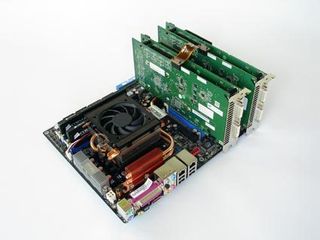Nvidia's Response to Early DIY Quad-SLI
"Quad SLI Is Now Being Enabled"

Nvidia states that "Quad SLI is now being enabled for the enthusiast DIY market using two GeForce 7950 GX2 boards, which are shorter in length and easier to integrate into many enthusiast-class PC system chassis." A beta program launched in late July, encouraging the community to participate in testing. In this program the company released an official beta driver, 91.37, which it hoped enthusiasts and testers would utilize. Nvidia wants community feedback to help reporting issues and for it to make comments. On Thursday Nvidia released the latest Quad-SLI enabled driver 91.45, and we will test with this release.

There is even a new middle section to the driver download selection screen specifically for Quad-SLI drivers.
From the conversations and this new documentation, Nvidia agrees that Quad-SLI performance varies from that of traditional dual card SLI from application to application. While Quad-SLI is targeted for high resolution and fully immersive gaming with pristine image quality, some applications run slower on Quad-SLI than on dual or single processor setups.
Nvidia notes in the reviewer's guide that "Quad-SLI is designed for extreme HD gaming at 2560x1600 with very high levels of anti-aliasing and filtering (i.e. 8X SLI-AA and 16X-AF). At resolutions lower than 1920x1200 and with low filtering settings, CPU-bound behavior is more prominent, and Quad-SLI may perform a bit slower than standard SLI due to additional driver overhead managing four GPUs."
We have commented on this in the past. For "Joe Gamer", who makes up the 95% or more of the population, Quad is not within the price range and the majority of gamers play at resolutions below 1600x1200. Professional and Pro-Am gamers typically gravitate to the fastest solutions for low resolution and low image quality settings for pinpoint accuracy in twitch and real-time strategy games.
DIY Quad-SLI is not for all, as we felt the pain of synchronizing Quad the first time we built a Quad-SLI system. It takes keen precision of hardware and a robust driver, and a powerful CPU to coordinate that much horsepower.
Stay on the Cutting Edge
Join the experts who read Tom's Hardware for the inside track on enthusiast PC tech news — and have for over 25 years. We'll send breaking news and in-depth reviews of CPUs, GPUs, AI, maker hardware and more straight to your inbox.
Current page: "Quad SLI Is Now Being Enabled"
Prev Page It's For "A Select User Base" Next Page Latency And OverheadMost Popular

